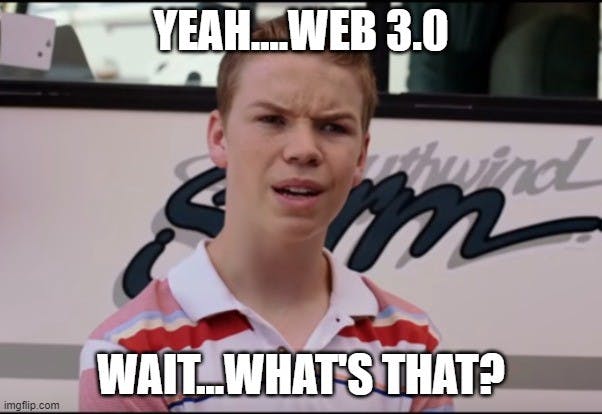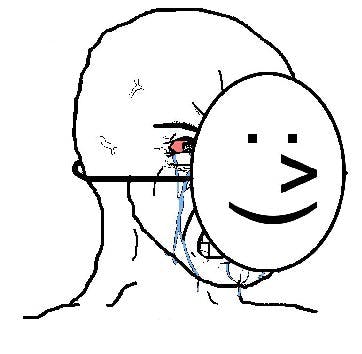If you have been in the tech space for some time, you must have probably heard about Web 3.0 and how it's different and 'better' than Web 2.0. But if you are just interested in downloading memes on the internet and doing your work, you might wonder what the hell everyone is talking about.
 In a previous article, I explained how the protocol that powers the Web has evolved. In this article, I will be providing an overview of the evolution of the Web itself.
In a previous article, I explained how the protocol that powers the Web has evolved. In this article, I will be providing an overview of the evolution of the Web itself.
Web1.0: In the Beginning 📜
Can you please open this web page in another window, The World Wide Web project (CERN.ch)?
What do you see? Do you see beautiful colors all over the page? What about pictures, flying texts, and animation? None of them is present, I'm afraid.
Well, that's because that is the first web page on the internet, and it was to serve a purpose: store and display information.
Sincerely speaking, web developers' job would be much easier if that's all we continued to do. I am not against innovation, just thinking out loud.

In the early days of the web, between the 1990s and early 2000s, the web consisted of static documents which could be navigated with the help of hyperlinks. This web version is referred to as Web 1.0 and is usually called the read-only web.
It was read-only because that's all we could do: visit a web page, read the information, go to other linked web pages, read more information.
Web 2.0: Can I Write too? ✍️
 Image by Werner Moser from Pixabay
Image by Werner Moser from Pixabay
Around 2004, the web had new capabilities due to advancements in web technologies. We could create web applications that allowed users to read things on the web and write on the web. Blogging blew up, Facebook, Google, and all the wonderful sites we have now gotten used to were ushered in.
This era of the web is dubbed Web 2.0. It felt like the ultimate goal; look at what became possible in Web 2.0. But over time, the problem with this model of the web became evident: who controls the data on the web?
In one of his interviews, Vitalik Buterin, the creator of Ethereum, said:
With online SaaS [Web 2], you have no control whatsoever. Initially, people didn't realize this because SaaS was a new and shiny thing. Over the last couple of years, people have realized this is the actual problem.
Even if the people in these organizations have good intentions, their incentive isn't naturally on the side [of the users].
He added that with web companies: "you are not their customers, therefore you are their product."
We have seen the abuse of user information by some big tech corporations; we have seen reports of users being monitored (illegally)) and their information being packaged and sold by some of these corporations. They have the power to misuse user data, and they are doing just that.
This problem of who controls the data on the web is what Web 3.0 aims to address.
Drum rolls🥁🥁
Web 3.0: The Decentralized Web 🤩
Web 3.0 promises a decentralized web - one in which there is no central authority. This means that the web will become more censorship-resistant. No single person can censor your content/data on the decentralized web.
The technology that makes this possible is the Blockchain Technology, the same technology that powers Bitcoin.
Web 3.0 promises that you will own your data (as it should be, right?), and you only give it out to corporations, services or businesses when you want - in exchange for value (as it should also be, right?).
There will be symbiotic relationships between users and platforms creators instead of the competitive relationship we know in Web 2.0. This relationship is possible via 'cryptonetworks', where the contract between the participants and the network is enforced in open source code.
There are other benefits of Web 3.0, and the fun fact is that since it's still in the early stages, some more benefits and use cases will be discovered along the way.
Yay!!👯♂️👯♂️
Some issues with Web 3.0👀
It will be unfair to talk about only the positives of Web 3.0, as we do say: nothing is perfect. Some of the issues of Web 3.0 includes:
Accessibility**: Web 3.0 is currently accessible to many people because there is a lack of integration in modern browsers that we are currently using. I believe that will change soon; in fact, the Brave browser provides native support.
- Scalability: Because Web 3.0 is decentralized, it isn't easy to scale. There is no 'single source of truth' in Web 3.0; this makes it difficult to scale the network.
- User Experience: Using Web 3.0 will require additional software and education, the tools we have for Web 2.0 has to be either augmented or replaced with tools for Web 3.0
- Cost: Decentralized apps usually put their code in the Blockchain (smart contracts), which is quite expensive.
Web 3.0 is a work in progress at the moment and most of what it promises isn't mainstream yet. In fact, some people are opposed to the idea and believe it's not here to stay. There are arguments for and against it and you can find some of them online.
But just like any new technology, it gets better over time and I believe the future of Web 3.0 is promising.
Conclusion💃
Yay!! We have come to the end of the article.
We have discussed the transition of the web from Web 1.0 to Web 3.0; we also mentioned the pros and cons of Web 3.0.
I cannot wait to learn more about Web 3.0 myself and build Decentralized Apps😇.
Happy Coding.
